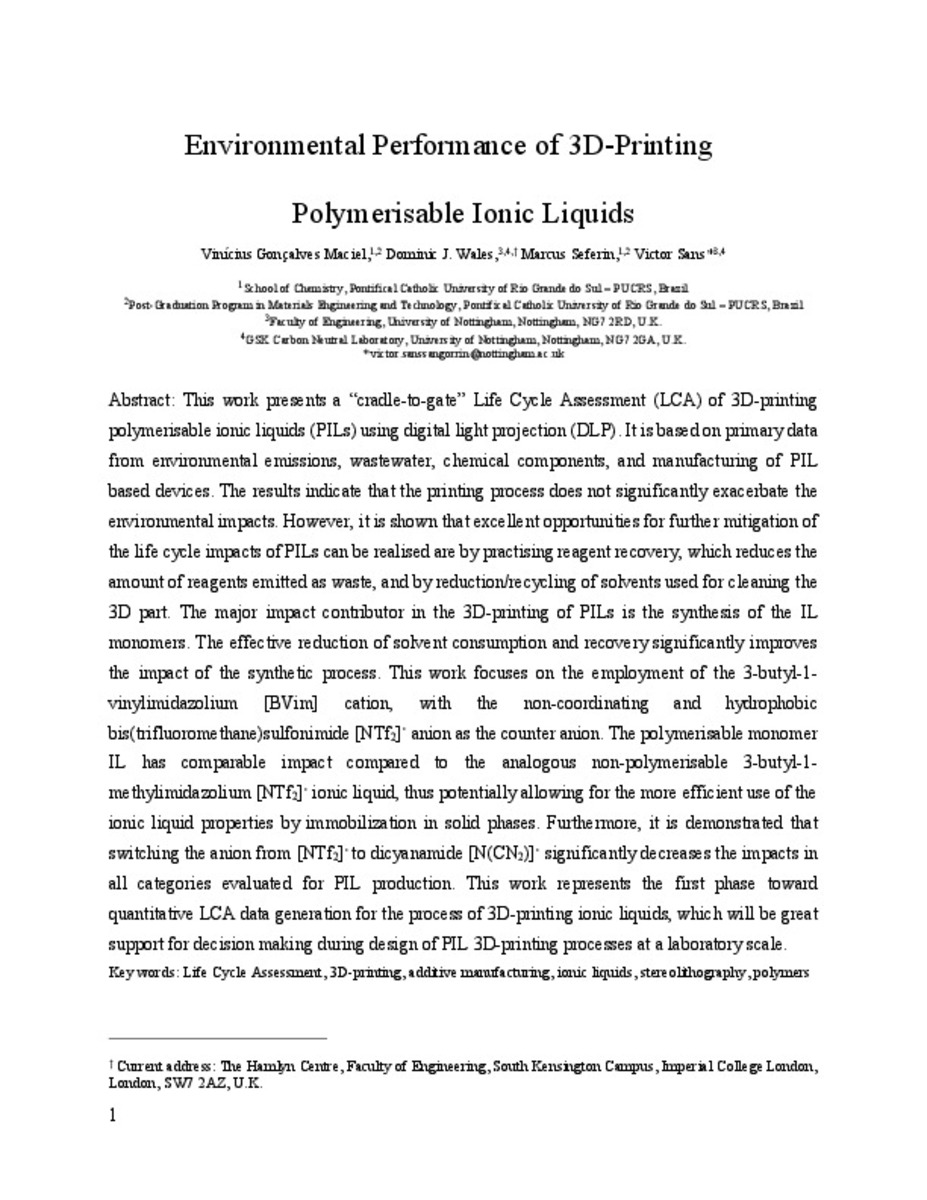Mostra el registre parcial de l'element
Environmental performance of 3D-Printing polymerisable ionic liquids
| dc.contributor.author | Gonçalves Maciel, Vinícius | |
| dc.contributor.author | Wales, Dominic | |
| dc.contributor.author | seferin, marcus | |
| dc.contributor.author | Sans, Victor | |
| dc.date.accessioned | 2019-11-18T10:32:47Z | |
| dc.date.available | 2019-11-18T10:32:47Z | |
| dc.date.issued | 2018-12-28 | |
| dc.identifier.citation | MACIEL, Vinícius Gonçalves, et al. Environmental performance of 3D-Printing polymerisable ionic liquids. Journal of cleaner production, 2019, 214: 29-40. | ca_CA |
| dc.identifier.uri | http://hdl.handle.net/10234/185008 | |
| dc.description.abstract | This work presents a “cradle-to-gate” Life Cycle Assessment (LCA) of 3D-printing polymerisable ionic liquids (PILs) using digital light projection (DLP). It is based on primary data from environmental emissions, wastewater, chemical components, and manufacturing of PIL based devices. The results indicate that the printing process does not significantly exacerbate the environmental impacts. However, it is shown that excellent opportunities for further mitigation of the life cycle impacts of PILs can be realised are by practising reagent recovery, which reduces the amount of reagents emitted as waste, and by reduction/recycling of solvents used for cleaning the 3D part. The major impact contributor in the 3D-printing of PILs is the synthesis of the IL monomers. The effective reduction of solvent consumption and recovery significantly improves the impact of the synthetic process. This work focuses on the employment of the 3-butyl-1-vinylimidazolium [BVim] cation, with the non-coordinating and hydrophobic bis(trifluoromethane)sulfonimide [NTf2]- anion as the counter anion. The polymerisable monomer IL has comparable impact compared to the analogous non-polymerisable 3-butyl-1-methylimidazolium [NTf2]- ionic liquid, thus potentially allowing for the more efficient use of the ionic liquid properties by immobilization in solid phases. Furthermore, it is demonstrated that switching the anion from [NTf2]- to dicyanamide [N(CN2)]- significantly decreases the impacts in all categories evaluated for PIL production. This work represents the first phase toward quantitative LCA data generation for the process of 3D-printing ionic liquids, which will be great support for decision making during design of PIL 3D-printing processes at a laboratory scale. | ca_CA |
| dc.format.extent | 12 p. | ca_CA |
| dc.format.mimetype | application/pdf | ca_CA |
| dc.language.iso | eng | ca_CA |
| dc.publisher | Elsevier | ca_CA |
| dc.rights | © 2018 Published by Elsevier Ltd. | ca_CA |
| dc.rights.uri | http://rightsstatements.org/vocab/InC/1.0/ | * |
| dc.subject | Life Cycle Assessment (LCA) | ca_CA |
| dc.subject | 3D-printing | ca_CA |
| dc.subject | additive manufacturing | ca_CA |
| dc.subject | ionic liquids | ca_CA |
| dc.subject | stereolithography | ca_CA |
| dc.subject | polymers | ca_CA |
| dc.title | Environmental performance of 3D-Printing polymerisable ionic liquids | ca_CA |
| dc.type | info:eu-repo/semantics/article | ca_CA |
| dc.identifier.doi | https://doi.org/10.1016/j.jclepro.2018.12.241 | |
| dc.rights.accessRights | info:eu-repo/semantics/openAccess | ca_CA |
| dc.relation.publisherVersion | https://www.sciencedirect.com/science/article/pii/S0959652618339635 | ca_CA |
| dc.date.embargoEndDate | 2020-12-28 | |
| dc.contributor.funder | Brazilian Government and the National Council for the Improvement of Higher Education (CAPES) ; University of Nottingham | ca_CA |
| dc.type.version | info:eu-repo/semantics/acceptedVersion | ca_CA |
Fitxers en aquest element
Aquest element apareix en la col·lecció o col·leccions següent(s)
-
FCA_Articles [507]
Articles de publicacions periódiques







